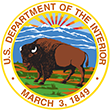Historic Preservation of the P-Ranch Beef Wheel
within Malheur National Wildlife Refuge
by Karla Mingus, Zone Archaeologist
U.S. Department of the Interior
U.S. Fish and Wildlife Service


U.S. Department of the Interior
U.S. Fish and Wildlife Service


Within the southern portion of Malheur National Wildlife Refuge (NWR), within the Blitzen Valley, sits the historic P-Ranch. The P-Ranch was the headquarters of the French-Glenn Livestock Company from 1872 – 1907. The 160 acre ranch was established in 1872 by Peter French with the financial backing of Dr. Hugh Glenn, under the Homestead Act of 1862. Soon after, French purchased a “P” cattle brand from a local mining prospector named Porter, this is where the P in P-Ranch originated. With the establishment of P-Ranch, French and Glenn soon became partners, and together they established the French-Glenn Livestock Company.
The French-Glenn Livestock Company continued to expand their holdings throughout the late 1800s to encompass an area of over 110,000 acres, in what is now Malheur NWR and the surrounding area including lands in the Blitzen, Catlow, Diamond, and Happy Valleys. Peter French continued to manage the company until his death in 1897, when he was killed over a land dispute near Sodhouse Ranch (near the Malheur NWR Headquarters). The French-Glenn Livestock Company was managed by the Glenn family until they sold the lands and company to Henry L. Corbett and C.E.S. Wood of Portland, Oregon in 1907. The lands located within the Blitzen Valley were later sold to the federal government in 1935 to become part of Malheur NWR.
The P-Ranch was the main headquarters for the French-Glenn Livestock Company and the residence of Peter French. Throughout French’s tenure (1872-1897) over 21 buildings and structures were constructed at the P-Ranch, these include: houses, a round barn, a long barn, a square barn, various sheds, a store, blacksmith shop, machine sheds, a beef wheel, fences, and corrals. Of these only the long barn, beef wheel, and sections of fences/corrals remain today. In addition, a garden, orchard, and shade trees were planted at the ranch; many of the poplars, cottonwood, and fruit trees remain in the area. The long barn was constructed in the late 1880s and was primarily used to house and feed horses. The beef wheel was constructed in the 1880s and was used to hoist and slaughter cattle for the consumption of beef by ranch staff. Fences and corrals were constructed throughout the 1870s, 1880s, and 1890s to contain livestock including horses and cattle.
The P-Ranch Beef Wheel remained standing for over 125 years when it collapsed during the winter of 2016/2017. As one of the few remaining beef wheels in Oregon, the U.S. Fish and Wildlife Service (FWS) set about restoring the beef wheel. This effort took several years until finally in 2019 the FWS secured funding to perform the restoration work on the beef wheel.
The restoration work consisted of replacing the broken juniper posts, which snapped in 2016/2017 causing the collapse of the beef wheel; and replacing/repairing the other broken wooden elements. The other wooden elements included the boards used to construct the square “wheel” and the wooden spindle. The restoration work was conducted by McIlrath Construction during the 2019 field season. The metal hardware, including the chain with hooks and metal spindle straps, were salvaged from the original beef wheel. However, the wooden elements were too deteriorated to reuse.
The P-Ranch is open to the public daily, from sunrise to sunset, and is located about 2 miles east of the town of Frenchglen in the southern portion of Malheur NWR. While at the P-Ranch visitors can explore the newly reconstructed beef wheel, the historic long barn, and the foundations and red-brick chimney of the original residence the “white house”. Trails and interpretive media can be found throughout the historic P-Ranch. To plan your visit to Malheur NWR and the P-Ranch, additional information can be found here. An interactive map along with printable maps and brochures of the refuge can be found here. The P-Ranch is #19 on the Auto Tour Route Brochure and # 9 and #10 on the Refuge Trails Brochure.